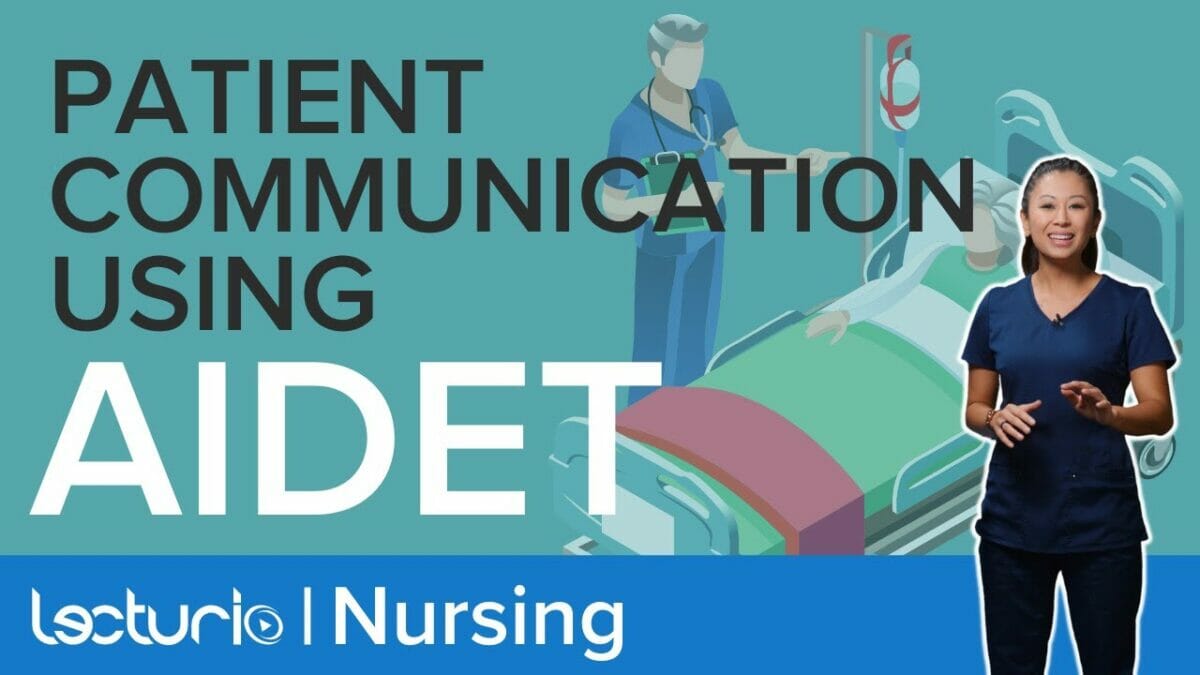What is AIDET?
AIDET is an acronym that stands for:
- Acknowledge
- Introduce
- Duration
- Explain
- Thank you
AIDET helps to outline all of the necessary steps for a positive patient interaction. Below, I’m sharing a breakdown of each step of AIDET and why they matter.
Acknowledge
The first part of AIDET is “acknowledge”. When you first walk into your patient’s room, you need to acknowledge their existence. Unfortunately, healthcare professionals sometimes enter and leave a patient’s room without addressing the patient directly (which is not the right approach).
Acknowledging a patient can be as simple as saying, “Good morning, Mrs. Smith.”
Remember, patients are people who deserve acknowledgment.
Introduce
Up next is “introduce”. Your patients will be seeing lots of different healthcare professionals throughout their stay at the hospital, so it is never safe to assume that they know who you are based on your scrub color or your name tag. Always introduce yourself when entering the room, for example,
“My name is Sophia, I’m going to be your nurse today.” If you’ve already seen your patient during that shift, you can still take this step when re-entering the room by saying something like, “Hi Mrs. Smith, it’s your nurse, Sophia, again.”
Duration
Duration means giving your patient an idea of the timeframe for whatever procedure or process is being performed. Whether you’re completing admission paperwork or inserting an IV, let them know how long they can expect the process to take.
For instance, say, “This will only take a few minutes,” or “I’m going to be in your room for a little while since this paperwork is a bit lengthy.”
This helps to give them an idea of how long they can expect to be waiting for the process to be completed.
Explanation
The next step of AIDET is “explanation,” which means providing your patient with a clear description of what’s going on. Examples include,
“I’m going to insert an IV into your arm. It’s hospital policy for all patients to have an IV in case of an emergency. Plus, your doctor has ordered us to administer some fluids through the IV to help rehydrate you.”
Let’s be honest, your patient needs to know what’s going on. Being in the hospital is scary and a lot of things feel out of the patient’s control.
Keeping them in the know helps to empower them and gives them a sense of control. While you’re explaining things to your patient, make sure to give them an opportunity to ask any questions they may have. This benefits not only the patient but also you. If there is a negative outcome later, you’ll know that you took all necessary steps to keep them informed about the process.
Thank You
Lastly, always thank the patient following your patient interaction. This is a simple way to show respect to your patient and help to build rapport so that future interactions feel cordial and positive.
Let’s put it all together!
Here is a communication example with all of the steps of AIDET put together:
“Good morning, Mrs. Smith. My name is Sophia, I’m going to be your nurse today. I’m going to be here in the room with you for a few minutes while I get you all settled in and complete your admission paperwork. I’m going to insert an IV into your arm as well since it is hospital policy for all patients to have an IV during their stay. Your doctor has ordered some IV fluids, which we will administer through the IV to keep you hydrated. Please let me know if you have any questions.” (Pause to allow time for questions)
“Thank you for letting me get all of this done, I’ll be back soon to check on you.”
Why is Patient Communication Important?
Being a patient in the hospital can be frightening. Nurses hold a lot of power in helping patients feel safe in this overwhelming environment where many things are beyond their control. As the nurse, you’ll likely spend more time with your patient than any other healthcare professional on the care team. For this reason, you want to take steps to communicate well with your patients in order to ensure positive patient outcomes.
Patient communication may feel a little awkward at first, especially if you’re more soft-spoken, like me. However, it’s better to communicate awkwardly with patients than not communicate at all. Never make assumptions as a nurse. Always speak up about any questions you have or anything that you feel the patients need to know. It is better to over-communicate than under-communicate.
By communicating clearly with your patient, you’re building trust and rapport. This helps them feel safe, seen, and heard. It empowers patients to discuss any questions or concerns with you, which helps you relay any important information to other members of the healthcare team, resulting in better healthcare outcomes overall.
How to Communicate with Patients Who Can’t Communicate
There is a good chance that you’ll sometimes care for patients who can’t actually communicate for themselves. They might have dementia, so they don’t understand what you’re saying and don’t know how to respond, they could be a baby or child who can’t yet speak, or they may speak a different language.
There are many different circumstances in which traditional communication is hindered for the patient and nurse. This does not mean that you’ll no longer take steps to communicate with your patient, actually, it’s quite the opposite.
When your patient can’t communicate for themselves, you’ll need to take extra steps to communicate with them to help them feel safe. Some examples include:
- Using an interpreter: If your patient does not speak the same language as you, you’ll need to use an interpreter to communicate. This might be an in-person interpreter or a computerized one. Some hospitals have a computer you can bring into the room, allowing an interpreter to join a video chat and facilitate communication between you and the patient.
- Speaking with the family: When caring for minors or adults who cannot speak for themselves, you may need to speak with the patient’s family about any procedures or necessary information regarding their hospital stay.
- Use body language: Nursing is a nurturing and impactful profession. You may communicate with your patient with simple body language cues, such as making eye contact or gently squeezing their hand. They may or may not be aware of these forms of communication, but it is worth it to try.
My Experience with Patient Communication as a Nurse
I am a naturally more introverted person, so I would say that patient communication was a bit awkward for me in the beginning. Luckily, I worked in the service industry before being a nurse, and going to nursing school gave me some practice with bedside communication. I hadn’t heard of AIDET in nursing school, but I wish I had because it is a very helpful acronym that covers all the necessary aspects.
As a nurse, I’ve seen firsthand how impactful strong communication can be for a patient (especially those having a tough time or feeling upset).
My advice to any new nurse is to remain patient and kind, to the best of your ability. You will deal with difficult patients who want to blame you for whatever problems are going on. This can be stressful, especially when you yourself are having a hard or busy day. Do your best to put yourself in your patient’s shoes and understand that they are probably just scared more than anything. Remaining calm can help diffuse the situation.
Final Thoughts
Strong patient communication is absolutely essential for nurses. Many nurses are naturally outgoing but those who aren’t will quickly feel pushed to get out of their comfort zone in order to communicate well with patients. Keeping patients informed about their hospital stay helps them remain calm and contributes to positive patient outcomes. Using AIDET when you interact with patients ensures that you’ve covered all important steps for positive patient communication.




